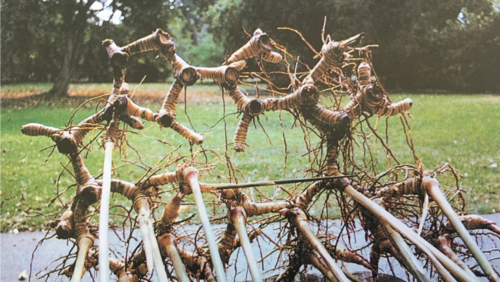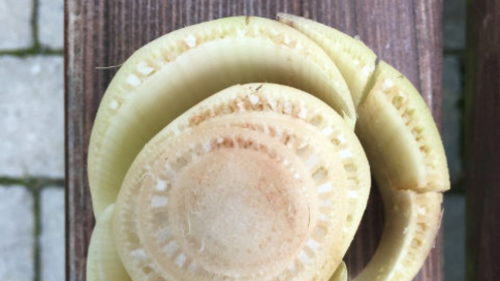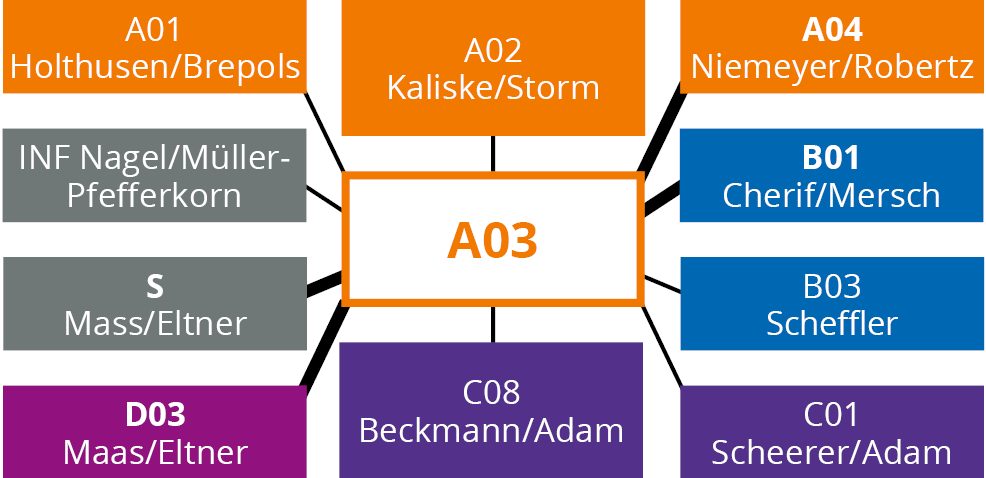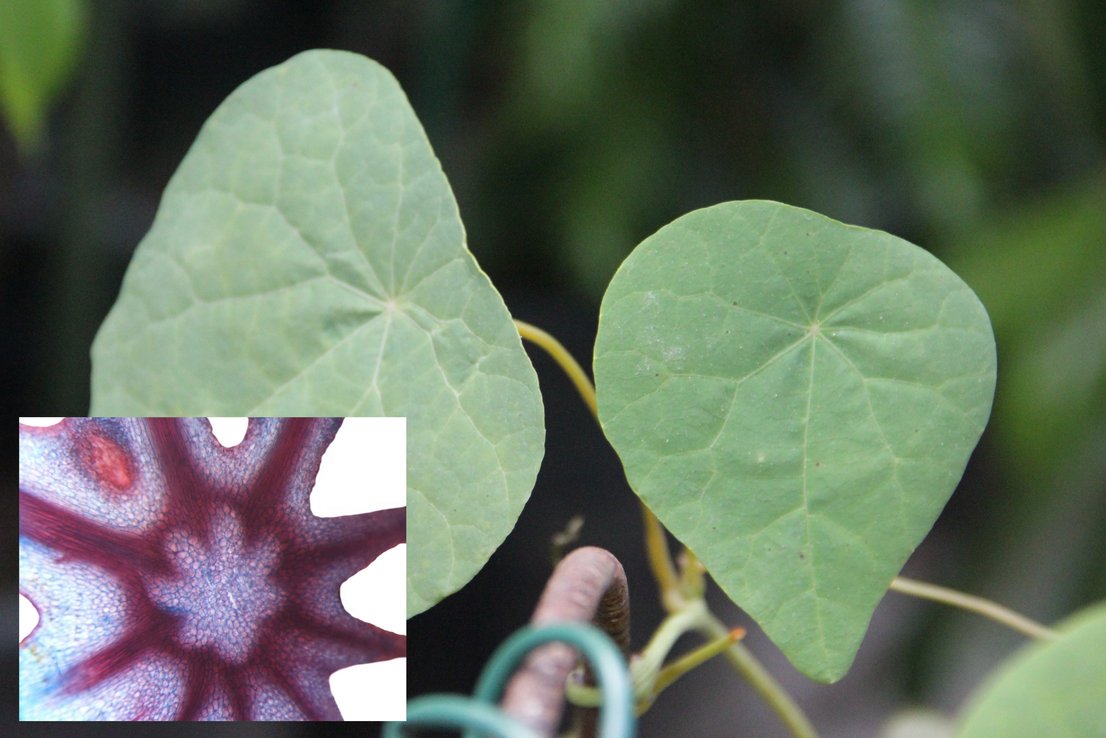Fiber-reinforced plant organs as inspiration for carbon fiber reinforced concrete structures | Funding Period 2
The research project investigates efficient, material-saving construction principles in plants that can serve as models for carbon fiber reinforced concrete (CRC). In the first funding period of TRR 280, promising results were achieved, especially in peltate leaves and adventitious roots. It was shown that the specific arrangements of vascular bundles and fibers in these plant structures offer effective approaches for the development of CRC components.
Main objectives:
- Identification of construction principles: The research aims to identify construction principles from plants that can be transferred to CRC components.
- Model transfers: The results of the first funding period will be implemented in model components and finally in first CRC components that include the construction principles of peltate leaves.
Research focus of the second funding period:
- Rhizomes: Subterranean rhizomes, such as those found in plants of the Bambusoidae and Zingiberaceae, serve as models for load-bearing elements in civil engineering. These rhizomes often show a complex network that extends horizontally in the soil and is subject to large bending forces at the joints. Understanding these structures could contribute to the development of robust, dissolved foundations in the construction industry.
- Banana pseudostems: These structures consist of intertwined, C-shaped petioles and are remarkably light and material efficient. They offer high bending stiffness and adaptability to different loads, making them ideal models for the development of flexible and robust building materials.
- Double-curved bracts: The bracts of the Araceae, especially the genus Amorphophallus, are examples of thin-walled shell structures. These plants show high mechanical stability despite low material investment. Their analysis could provide inspiring approaches for the development of self-supporting, resource-saving CRC shell structures.



Scientists
![Prof. Dr. rer. nat. habil. Christoph Neinhuis [Translate to English:] Prof. Dr. rer. nat. habil. Christoph Neinhuis](/fileadmin/_processed_/5/c/csm_A_Neinhuis_Quadratisch_c3d19e4f50.jpg)
D-01062 Dresden (Germany)
![Dr. rer. nat. Thea Lautenschläger [Translate to English:] Dr. rer. nat. Thea Lautenschläger](/fileadmin/_processed_/3/b/csm_A_Lautenschlaeger_Quadratisch_a6a11542ad.jpg)
D-22609 Hamburg (Germany, bis | until 2022 TU Dresden)
![M.Sc. Tom Morgenstern [Translate to English:]](/fileadmin/_processed_/c/4/csm_A03_Morgenstern_quadratisch__67bb12c4f3.jpg)
22609 Hamburg (Germany)
Cooperations

Ehemalige / Former involved
Annabell Rjosk, M.Sc. (Research Associate, TU Dresden, 07/2020 – 06/2024)
Bennett Pauls, M.Sc. (Research Associate, TU Dresden, 07/2020 – 06/2024)
Fiber Reinforced Plant Organs as Inspiration for Carbon Fiber Reinforced Concrete Constructions | Funding Period 1
In project A03, plant organs and structures are investigated in order to derive inspiration for novel carbon-reinforced concrete constructions. The project is divided into two strands: the investigation of peltate leaves and the investigation of shoot-root transitions.
Characterisation of the petiole-lamina-transition zone
Aim of this project is the anatomical, morphological and biomechanical characterisation of the petiole-lamina-transition zone in peltate leaves, meaning leaves with the petiole inserted centrally or eccentrically on the underside of the lamina. We focus on the comparative analysis of fiber course and orientation at the petiole-lamina-junction of herbaceous, short-lived leaves. On one hand representatives, similar in morphology but different in size and weight, will be examined. On the other hand representatives with large-scale leaves with different morphology will be studied in terms of various structural principles in the junction between petiole and lamina.
With the goal to serve as a biological inspiration for the development of new carbon-reinforced concrete components, the analysis of these principles focuses on the application of force, damping behavior at the junctions and fiber-matrix-connection.

Characterization of root-stem-junctions
The aim of this part of the project is the anatomical, morphological and biomechanical characterization of root-stem-junctions in fast growing and lightly or non-lignified plants, especially for aerial prop roots. The emphasis is on plants with either a hollow structure or a core of non-loadbearing tissue. The supporting tissues are thus situated on the outer regions of the shoot. These principles will be investigated for the use in carbon-reinforced concrete structures with a focus on force transmission, dampening characteristics in the knot and fiber-matrix transition.
Of additional interest is the adaptive growth of selected plants. This happens as a response to the increased self load during natural growth as well as under external influences such as wind loads or inclined growth. These adaptation strategies will serve as inspiration for the development of carbon-reinforced concrete structures.


Publikationen | Publications
Friese, D.; Rjosk, A.; Hahn, L.; Lautenschläger, Th.; Neinhuis, Chr.; Cherif, Ch. (2022) Development of an application-oriented Yarn Impregnation and Fixation Technology for the Robot-supported Manufacturing of Biologically Inspired Load Adapted 3D Textile Reinforcement Structures in: Stokkeland, S.; Braarud, H. C. [eds.] Concrete Innovation for Sustainability – Proc. for the 6th fib Int. Congress 2022, 12.–16.06.2022 in Oslo (Norway), Oslo: Novus Press, p. 715–725.
Macek, D.; Holthusen, H.; Rjosk, A.; Ritzert, S.; Lautenschläger, T.; Neinhuis, C.; Simon, J.-W.; Reese, S. (2023) A constitutive model for modeling the mechanical behavior of the peltate leaf of Stephania japonica (Menispermaceae) in: Proceedings in Applied Mathematics and Mechanics 23, issue 3, Special Issue: 93rd Annual Meeting of the International Association of Applied Mathematics and Mechanics (GAMM), e202200288 – DOI: https://doi.org/10.1002/pamm.202200288
Macek, D.; Rjosk, A.; Ritzert, S.; Lautenschläger, T.; Neinhuis, Chr.; Reese, S. (2023) Numerical Simulations of the Mechanical Behavior of Plant Tissues as an Inspiration for Carbon Reinforced Concrete Structures in: Ilki, A.; Çavunt, D.; Çavunt, Y. S. [eds.] Building for the Future: Durable, Sustainable, Resilient – Proc. of fib Symposium 2023, 05.–07.06.2023 in Istanbul (Turkey), publ. in: Lecture Notes in Civil Engineering 350, Cham: Springer, p. 1408–1417 – https://doi.org/10.1007/978-3-031-32511-3_144
Macek, D.; Rjosk, A.; Ritzert; S.; Lautenschläger, T.; Neinhuis, C.; Reese, S. (2023) Pflanzengewebe als Inspiration für Carbonbeton-Strukturen: Morphologie und mechanisches Verhalten in: Bauingenieur 98, issue 07–08, p. 227–233 – DOI: 10.37544/0005-6650-2023-07-08-49
Pauls, B.; Lautenschläger, T.; Neinhuis, C. (2023) Anatomical and Biomechanical Properties of the Junction between Stem and Aerial Roots ofSelenicereus undatus in: Plants 12, issue 13, 2544 – DOI: 10.3390/plants12132544
Platen, J.; Pauls, B.; Rjosk, A.; Lautenschläger, T.; Neinhuis, Chr.; Kaliske, M. (2023) Modeling Growth of Plants for Biologically Inspired Structures of Carbon Fiber Reinforced Concrete in: Ilki, A.; Çavunt, D.; Çavunt, Y. S. [eds.] Building for the Future: Durable, Sustainable, Resilient – Proc. of fib Symposium 2023, 05.–07.06.2023 in Istanbul (Turkey), publ. in: Lecture Notes in Civil Engineering 350, Cham: Springer, p. 1262–1272 – https://doi.org/10.1007/978-3-031-32511-3_129
Rjosk, A.; Neinhuis, C.; Lautenschläger, T. (2022) Anatomy and Biomechanics of Peltate Begonia Leaves—Comparative Case Studies in: Plants 11, issue 23, 3297 – https://doi.org/10.3390/plants11233297
Ritzert, S.; Rjosk, A.; Holthusen, H.; Lautenschläger, T.; Neinhuis, C.; Reese, S. (2024) Mechanical modeling of the petiole-lamina transition zone of peltate leaves in: Acta Biomaterialia, Vol. 187, 278–290 – DOI: https://doi.org/10.1016/j.actbio.2024.08.019
Wunnenberg, J.; Rjosk, A.; Neinhuis, C.; Lautenschläger, T.(2021)Strengthening structures in the petiole-lamina junction of peltate leaves in: Biomimetics 6, issue 2 – https://doi.org/10.3390/biomimetics6020025
Vorträge und Poster | Oral presentations and posters
Macek, D.; Holthusen, H.; Rjosk, A.; Ritzert, S.; Lautenschläger, T.; Neinhuis, C.; Simon, JW.; Reese, S. (2022) A constitutive model for modeling the mechanical behavior of the peltate leaf of Stephania japonica (Menispermaceae) oral presentation at: 92nd Annual Meeting of the International Association of Applied Mathematics and Mechanics, 15.–19.08.2022 in Aachen
Pauls, B.; Hesse, L.; Lautenschläger, T.; Neinhuis, C. (2023) Aerial root insertion in stems of Epipremnum aureum - a model for fiber reinforced junctions poster at: 10. Bionik-Kongress, 12./13.05.2023 in Bremen
Pauls, B.; Lautenschläger, T.; Neinhuis, C. (2022) Strength and failure mode of the junction between stem and aerial roots of Hylocereus undatus poster at: 10th International Plant Biomechanics Conference, 21.–26.08.2022 in Lyon (France)
Pauls, B.; Platen, J.; Kaliske, M.; Lautenschläger, T.; Neinhuis, C. (2023) Plant Growth as Inspiration for Novel Carbon Concrete Components poster at: 10. Bionik-Kongress, 12./13.05.2023 in Bremen
Ritzert, S.; Holthusen, H.; Macek, D.; Rjosk, A.; Lautenschläger, T.; Neinhuis, C.; Reese, S. (2023) Modeling technique for petiole-lamina connections of peltate leaves in: ECCOMAS 7th Young Investigators Conference YIC, 19.–21.06.2023 in Porto (Portugal, proceedings in preparation)
Rjosk, A.; Neinhuis, C.; Lautenschläger, T. (2022) Anatomy and biomechanics of peltate Begonia leaves oral presentation at: 10th International Plant Biomechanics Conference, 21.–26.08.2022 in Lyon (France)
Rjosk, A.; Ritzert, S.; Macek, D.; Friese, D.; Neef, T.; Mechtcherine, V.; Cherif, C.; Reese, S.; Neinhuis, C.; Lautenschläger, T. (2023) A new approach to construction: using peltate leaves as inspiration in the design of novel carbon fibre reinforced concrete building components oral presentation at: 10. Bionik-Kongress, 12.-13.05.2023 in Bremen (proceedings in preparation)
Studentische Arbeiten | Student's works
Morgenstern, T. (TP A03) Anatomische und biomechanische Untersuchung von Blättern peltater Arten [Bachelorarbeit].
Calderon Barrientos, R. F. (TP A03) Morphologische, anatomische und mechanische Untersuchung der Luftwurzeln von Epipremnum aureum [Bachelorarbeit].
Kupfer, A. (TP A03) Untersuchung der Methode zur indirekten Turgorbestimmung bei Petioli peltater Blätter [Bachelorarbeit].




